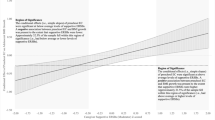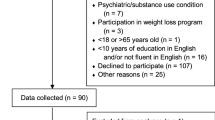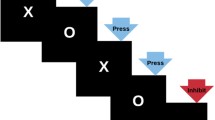Abstract
Purpose of review
Studies on obesogenic eating behaviors in young children have mainly focused on the roles of family environment and parental behaviors. However, intrapersonal characteristics, particularly executive functions, have recently gained more attention in the literature. Therefore, herein we review work on children’s executive functions (EFs), particularly the roles of cold and hot executive functions on children’s obesogenic eating behaviors.
Recent findings
Most work examining the associations between EF and obesogenic eating among children has focused on the cool EF, particularly inhibitory control/impulsivity. Findings have consistently showed that deficits in inhibitory control/impulsivity are associated with overeating and food responsiveness. The roles of the other two cool EFs (attention control/shifting and working memory) and hot EF (delay of gratification and affective decision-making) in contributing to child obesogenic eating are less clear. For instance, the association between children’s performance on delay of gratification tasks and obesogenic eating varies depending on whether food or non-food rewards were used; children with poorer delay of gratification in non-food tasks had more obesogenic eating, although children with poorer delay of gratification in food tasks had less obesogenic eating.
Summary
Deficits in inhibitory control/impulsivity are associated with more obesogenic eating, suggesting that improving children’s inhibition may reduce overeating and childhood obesity. The roles of other cool and hot components of EFs in contributing to obesogenic eating require further study.
Similar content being viewed by others
References
Papers of particular interest, published recently, have been highlighted as: • Of importance •• Of major importance
Ogden CL, Carroll MD, Kit BK, Flegal KM. Prevalence of childhood and adult obesity in the United States, 2011-2012. JAMA. 2014;311(8):806–14.
Raitakari O, Juonala M, Viikari J. Obesity in childhood and vascular changes in adulthood: insights into the Cardiovascular Risk in Young Finns Study. Int J Obes. 2005;29:S101–S4.
Reilly J, Kelly J. Long-term impact of overweight and obesity in childhood and adolescence on morbidity and premature mortality in adulthood: systematic review. Int J Obes. 2010;35(7):891–8.
Luppino FS, de Wit LM, Bouvy PF, Stijnen T, Cuijpers P, Penninx BW, et al. Overweight, obesity, and depression: a systematic review and meta-analysis of longitudinal studies. Arch Gen Psychiatry. 2010;67(3):220–9.
Moens E, Braet C, Soetens B. Observation of family functioning at mealtime: a comparison between families of children with and without overweight. J Pediatr Psychol. 2007;32(1):52–63.
Mazzeschi C, Pazzagli C, Laghezza L, De Giorgi G, Reboldi G, De Feo P. Parental alliance and family functioning in pediatric obesity from both parents’ perspectives. J Dev Behav Pediatr. 2013;34(8):583–8.
Halliday J, Palma C, Mellor D, Green J, Renzaho A. The relationship between family functioning and child and adolescent overweight and obesity: a systematic review. Int J Obes. 2014;38(4):480–93.
Francis L, Birch L. Maternal weight status modulates the effects of restriction on daughters’ eating and weight. Int J Obes. 2005;29(8):942–9.
Goulding AN, Rosenblum KL, Miller AL, Peterson KE, Chen Y-P, Kaciroti N, et al. Associations between maternal depressive symptoms and child feeding practices in a cross-sectional study of low-income mothers and their young children. Int J Behav Nutr Phys Act. 2014;11(1):75.
Kalinowski A, Krause K, Berdejo C, Harrell K, Rosenblum K, Lumeng JC. Beliefs about the role of parenting in feeding and childhood obesity among mothers of lower socioeconomic status. J Nutr Educ Behav. 2012;44(5):432–7.
Pesch MH, Harrell KJ, Kaciroti N, Rosenblum KL, Lumeng JC. Maternal styles of talking about child feeding across sociodemographic groups. J Am Diet Assoc. 2011;111(12):1861–7.
Rollins BY, Savage JS, Fisher JO, Birch LL. Alternatives to restrictive feeding practices to promote self-regulation in childhood: a developmental perspective. Pediatr Obes. 2016;11(5):326–32.
Birch LL. Child feeding practices and the etiology of obesity. Obesity. 2006;14(3):343–4.
Birch LL, Fisher J, Grimm-Thomas K, Markey C, Sawyer R, Johnson SL. Confirmatory factor analysis of the Child Feeding Questionnaire: a measure of parental attitudes, beliefs and practices about child feeding and obesity proneness. Appetite. 2001;36(3):201–10.
Rollins BY, Loken E, Savage JS, Birch LL. Maternal controlling feeding practices and girls’ inhibitory control interact to predict changes in BMI and eating in the absence of hunger from 5 to 7 y. Am J Clin Nutr. 2014;99(2):249–57.
Fogel A, Goh AT, Fries LR, Sadananthan SA, Velan SS, Michael N, et al. A description of an ‘obesogenic’eating style that promotes higher energy intake and is associated with greater adiposity in 4.5 year-old children: results from the GUSTO cohort. Physiol Behav. 2017;176:107–16.
Hill C, Llewellyn C, Saxton J, Webber L, Semmler C, Carnell S, et al. Adiposity and ‘eating in the absence of hunger’in children. Int J Obes. 2008;32(10):1499–505.
van Strien T, Oosterveld P. The children’s DEBQ for assessment of restrained, emotional, and external eating in 7- to 12-year-old children. Int J Eat Disord. 2008;41(1):72–81.
Jansen PW, Roza SJ, Jaddoe V, Mackenbach JD, Raat H, Hofman A, et al. Children’s eating behavior, feeding practices of parents and weight problems in early childhood: results from the population-based Generation R Study. Int J Behav Nutr Phys Act. 2012;9(1):130.
Ashcroft J, Semmler C, Carnell S, Van Jaarsveld C, Wardle J. Continuity and stability of eating behaviour traits in children. Eur J Clin Nutr. 2007;62(8):985–90.
Scaglioni S, Arrizza C, Vecchi F, Tedeschi S. Determinants of children’s eating behavior. Am J Clin Nutr. 2011;94(6 Suppl):2006S–11S. 2011S
Birch LL, Fisher JO. Development of eating behaviors among children and adolescents. Pediatrics. 1998;101(Supplement 2):539–49.
Wardle J, Guthrie C, Sanderson S, Rapoport L. Development of the Children’s Eating Behavior Questionnaire. J Child Psychol Psychiatr. 2001;42(7):963–70.
Webber L, Hill C, Saxton J, Van Jaarsveld C, Wardle J. Eating behaviour and weight in children. Int J Obes. 2008;33(1):21–8.
Barkeling B, Ekman S, Rössner S. Eating behaviour in obese and normal weight 11-year-old children. Int J Obes Related Metab Disorders: J Int Assoc Study Obes. 1992;16(5):355–60.
Tan CC, Holub SC. Children’s self-regulation in eating: associations with inhibitory control and parents’ feeding behavior. J Pediatr Psychol. 2011;36(3):340–5.
Cross MB, Hallett AM, Ledoux TA, O'Connor DP, Hughes SO. Effects of children’s self-regulation of eating on parental feeding practices and child weight. Appetite. 2014;81:76–83.
Orrell-Valente JK, Hill LG, Brechwald WA, Dodge KA, Pettit GS, Bates JE. “Just three more bites”: an observational analysis of parents’ socialization of children’s eating at mealtime. Appetite. 2007;48(1):37–45.
Gowey MA, Lim CS, Dutton GR, Silverstein JH, Dumont-Driscoll MC, Janicke DM. Executive function and dysregulated eating behaviors in pediatric obesity. J Pediatr Psychol. 2017;
•• Groppe K, Elsner B. Executive function and food approach behavior in middle childhood. Frontiers in psychology. 2014;5. This study demonstrates attention shifting, working memory, and inhibitory control components cohered into a latent construct of cool executive function. In addition, it examines how cool and hot executive functions relate to children’s eating behaviors.
Hayes JF, Eichen DM, Barch DM, Wilfley DE. Executive function in childhood obesity: promising intervention strategies to optimize treatment outcomes. Appetite. 2017
Hughes SO, Power TG, O'Connor TM, Fisher JO. Executive functioning, emotion regulation, eating self-regulation, and weight status in low-income preschool children: how do they relate? Appetite. 2015;89:1–9.
Dohle S, Diel K, Hofmann W. Executive functions and the self-regulation of eating behavior: a review. Appetite. 2017
• Pieper JR, Laugero KD. Preschool children with lower executive function may be more vulnerable to emotional-based eating in the absence of hunger. Appetite. 2013;62:103–9. The first study that examines the role of executive function on preschoolers’ eating behaviors.
Leung CY, Lumeng JC, Kaciroti NA, Chen YP, Rosenblum K, Miller AL. Surgency and negative affectivity, but not effortful control, are uniquely associated with obesogenic eating behaviors among low-income preschoolers. Appetite. 2014;78:139–46.
Diamond A. Executive functions. Annu Rev Psychol. 2013;64:135–68.
Garon N, Bryson SE, Smith IM. Executive function in preschoolers: a review using an integrative framework. Psychol Bull. 2008;134(1):31–60.
Best JR, Miller PH, Naglieri JA. Relations between executive function and academic achievement from ages 5 to 17 in a large, representative national sample. Learn Individ Differ. 2011;21(4):327–36.
Barkin SL. The relationship between executive function and obesity in children and adolescents: a systematic literature review. J Obes. 2013;2013
Miller AL, Lee HJ, Lumeng JC. Obesity-associated biomarkers and executive function in children. Pediatr Res. 2014;
Liang J, Matheson B, Kaye W, Boutelle K. Neurocognitive correlates of obesity and obesity-related behaviors in children and adolescents. Int J Obes. 2014;38(4):494–506.
Smith E, Hay P, Campbell L, Trollor JN. A review of the association between obesity and cognitive function across the lifespan: implications for novel approaches to prevention and treatment. Obes Rev. 2011;12(9):740–55.
Mischel W, Shoda Y, Rodriguez MI. Delay of gratification in children. Science. 1989;244(4907):933–8.
Metcalfe J, Mischel W. A hot/cool-system analysis of delay of gratification: dynamics of willpower. Psychol Rev. 1999;106(1):3–19.
Mischel W, Ayduk O. Willpower in a cognitive-affective processing system. Handbook of Self-Regul: Res Theory and Appl 2004:99–129.
Zelazo PD, Müller U. Executive function in typical and atypical Development 2002.
Happaney K, Zelazo PD, Stuss DT. Development of orbitofrontal function: current themes and future directions. Brain Cogn. 2004;55(1):1–10.
•• Groppe K, Elsner B. The influence of hot and cool executive function on the development of eating styles related to overweight in children. Appetite. 2015;87:127–36. A longitudinal study examines how cool and hot executive functions predict children’s eating behavior 1 year later.
Maayan L, Hoogendoorn C, Sweat V, Convit A. Disinhibited eating in obese adolescents is associated with orbitofrontal volume reductions and executive dysfunction. Obesity. 2011;19(7):1382–7.
Verdejo-García A, Pérez-Expósito M, Schmidt-Río-Valle J, Fernández-Serrano MJ, Cruz F, Pérez-García M, et al. Selective alterations within executive functions in adolescents with excess weight. Obesity. 2010;18(8):1572–8.
Scholten EW, Schrijvers CT, Nederkoorn C, Kremers SP, Rodenburg G. Relationship between impulsivity, snack consumption and children’s weight. PLoS One. 2014;9(2):e88851.
Guerrieri R, Nederkoorn C, Jansen A. The interaction between impulsivity and a varied food environment: its influence on food intake and overweight. Int J Obes. 2008;32(4):708–14.
Levitan R, Rivera J, Silveira P, Steiner M, Gaudreau H, Hamilton J, et al. Gender differences in the association between stop-signal reaction times, body mass indices and/or spontaneous food intake in pre-school children: an early model of compromised inhibitory control and obesity. Int J Obes. 2015;39(4):614–9.
• Nederkoorn C, Dassen FC, Franken L, Resch C, Houben K. Impulsivity and overeating in children in the absence and presence of hunger. Appetite. 2015;93:57–61. This study provides evidence that children with poorer inhibition preferred and consumed more unhealthy food.
• Power TG, Olivera YA, Hill RA, Beck AD, Hopwood V, Garcia KS, et al. Emotion regulation strategies and childhood obesity in high risk preschoolers. Appetite. 2016;107:623–7. This study illustrates that food-related delay of gratification was associated with more eating in the absence of hunger.
Bonato DP, Boland FJ. Delay of gratification in obese children. Addict Behav. 1983;8(1):71–4.
Bub KL, Robinson LE, Curtis DS. Longitudinal associations between self-regulation and health across childhood and adolescence. Health Psychol : Off J Div Health Psychol Am Psychol Assoc. 2016;35(11):1235–45.
Caleza C, Yañez-Vico RM, Mendoza A, Obesity I-LAC, Behavior DG. A systematic review of experimental studies. J Ped. 2016;169:201–7. e1.
Johnson WG, Parry W, Drabman RS. The performance of obese and normal size children on a delay of gratification task. Addict Behav. 1978;3(3–4):205–8.
Schlam TR, Wilson NL, Shoda Y, Mischel W, Ayduk O. Preschoolers’ delay of gratification predicts their body mass 30 years later. J Pediatr. 2013;162(1):90–3.
Seeyave D, Coleman S, Appugliese D, Corwyn R, Bradley R, Davidson N, et al. Ability to delay gratification at age 4 years and risk of overweight at age 11 years. Arch Pediatr Adolesc Med. 2009;163(4):303–8.
Miller AL, Rosenblum KL, Retzloff LB, Lumeng JC. Observed self-regulation is associated with weight in low-income toddlers. Appetite. 2016;105:705–12.
Kjelsås E, Bjørnstrøm C, Götestam KG. Prevalence of eating disorders in female and male adolescents (14–15 years). Eat Behav. 2004;5(1):13–25.
Raevuori A, Keski-Rahkonen A, Hoek HW. A review of eating disorders in males. Curr Opin Psychiatry. 2014;27(6):426–30.
Frazier-Wood AC, Carnell S, Pena O, Hughes SO, O'Connor TM, Asherson P, et al. Cognitive performance and BMI in childhood: shared genetic influences between reaction time but not response inhibition. Obesity. 2014;22(11):2312–8.
Jiang Q, He D, Guan W, He X. “Happy goat says”: the effect of a food selection inhibitory control training game of children’s response inhibition on eating behavior. Appetite. 2016;107:86–92.
Author information
Authors and Affiliations
Corresponding author
Ethics declarations
Conflict of Interest
Cin Cin Tan and Julie C. Lumeng declare they have no conflict of interest.
Human and Animal Rights and Informed Consent
This article does not contain any studies with human or animal subjects performed by any of the authors.
Additional information
This article is part of the Topical Collection on Maternal and Childhood Nutrition
Rights and permissions
About this article
Cite this article
Tan, C.C., Lumeng, J.C. Associations Between Cool and Hot Executive Functions and Children’s Eating Behavior. Curr Nutr Rep 7, 21–28 (2018). https://doi.org/10.1007/s13668-018-0224-3
Published:
Issue Date:
DOI: https://doi.org/10.1007/s13668-018-0224-3




